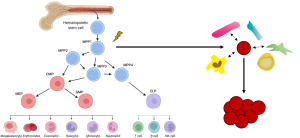Leukaemic Stem Cells and Acute Myeloid Leukaemia
Acute Myeloid Leukaemia (AML) is a heterogeneous disease of the haematopoietic system with a dismal prognosis. Two-year survival rates are 5-15% in cytogenetically poor risk patients, underlining the critical need for new therapies. Current approaches of induction chemotherapy and epigenetic modifiers have been hampered by the significant plasticity in the Leukaemic Stem Cell (LSC) epigenome and are insufficient to substantially improve patient outcomes. LSCs are the origins of relapse in AML and show substantial plasticity from de novo disease through to relapse, where they drive a more aggressive disease.

Figure. Illustration of the healthy haematopoietic system (left) and the malignant transformation to produce leukaemic cells, both LSCs and blasts, with LSCs surrounded by supportive niche cells (red, right).
Targeting proteostatic regulators in AML
We study the role of protein homeostasis in AML using a variety of novel inducible mouse models (Cancer Cell 2016) and primary patient samples (Science Translational Medicine 2022). By focussing on LSCs and their underlying biology, we design new methods for targeting drug resistance and relapse to improve overall survival in AML.

Figure. Left. Example tSNE plot demonstrating AML leukaemic stem cell subpopulations and co-expression of a novel target (CKS1). Right. Overall survival of patient derived xenograft models treated with novel chemotherapeutic approaches.
Key Research Priorities
We use inducible, reversible, mouse models of AML to study step-wise changes in the proteome and phosphoproteome of healthy haematopoietic cells to leukaemia.
Combining data-driven approaches (e.g. machine learning), in vivo imaging and functional interrogation, we study which factors are intrinsically and extrinsically regulated during AML development and drug resistance.
We use a range of approaches including degron tagging, small molecules inhibitors and synthesis of novel molecules to target drug resistant cells in leukaemia for a durable cure.